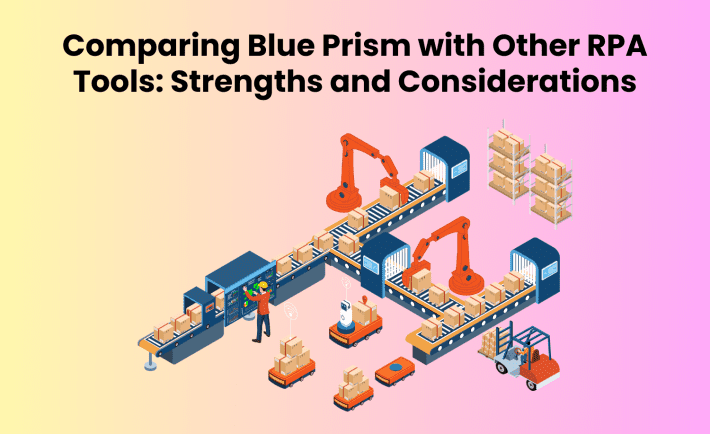
Blue Prism has long been a frontrunner among RPA tools with its innovative features and capabilities. Here in the blog, we’ll examine Blue Prism in-depth, contrasting it with other RPA solutions and discussing the pros and downsides of each. Professionals aiming for RPA Certification and businesses interested in RPA in general, and Blue Prism RPA in particular, may find this comparison very helpful.
Table of Contents
- What is Blue Prism RPA?
- Comparison with Other RPA Tools
- Ease of Use and Accessibility
- Scalability and Enterprise Readiness
- Integration and Compatibility
- Cognitive Capabilities and AI
- Community and Support
- Choosing the Right RPA Tool
- Conclusion
What is Blue Prism RPA?
Automation of complicated, rule-based procedures is made possible by the software platform known as Blue Prism RPA. Data management, transaction processing, and inter-system communication are all handled by a mix of AI and machine learning algorithms. Scalability, security, and robustness are the three defining characteristics of Blue Prism’s RPA strategy, making it the go-to for several large-scale businesses.
Comparison with Other RPA Tools
We can see where Blue Prism ranks in relation to other top RPA solutions by comparing it to UiPath, Automation Anywhere, and Pega Robotics.
1. Ease of Use and Accessibility
- UiPath: Known for its user-friendly interface, UiPath is often praised for its low entry barrier, making it ideal for beginners in RPA. It provides a drag-and-drop interface for a visual approach to automation.
- Automation Anywhere: This tool provides a balance between ease of use and advanced capabilities. Anyone may utilise it, regardless of their degree of technical knowledge.
- Pega Robotics: Pega is known for its enterprise-grade solutions and might have a more challenging learning curve than other options.
- Blue Prism: While Blue Prism offers robust features, it is often considered less intuitive for beginners compared to UiPath and Automation Anywhere. Those without a technological background may struggle with its UI.
2. Scalability and Enterprise Readiness
- UiPath and Automation Anywhere: Both tools provide excellent scalability and are widely adopted in various industries for large-scale implementations.
- Pega Robotics: Pega is well-known for its enterprise-level emphasis, and it is particularly good at scaling and integrating with other systems.
- Blue Prism: With its heavy focus on control, security, and governance, it stands out regarding enterprise preparedness. Complex, large-scale deployments are the sweet spot for Blue Prism.
3. Integration and Compatibility
- UiPath: Provides many options for integrating with other systems and apps.
- Anywhere Automation: Prominent for its robust API connections, which allow for easy connection with several apps.
- Pega Robotics: Organisations who aren’t already utilising Pega solutions may find it difficult to integrate with their current systems because of this focus on Pega integration.
- Blue Prism: Provides robust integration options but may require more technical expertise to set up complex integrations than UiPath and Automation Anywhere.
4. Cognitive Capabilities and AI
- UiPath and Automation Anywhere are two platforms that have come a long way in incorporating AI and ML, giving users access to powerful cognitive automation features.
- Pega Robotics: As part of its Business Process Management (BPM) package, Pega Robotics incorporates AI and provides advanced predictive analytics capabilities.
- Blue Prism: Regarding strong artificial intelligence capabilities, especially in analytics and process mining, Blue Prism’s Decipher and Digital Exchange platforms stand out.
5. Community and Support
- UiPath: Boasts a large community and extensive online resources, making it a popular choice for learning and troubleshooting.
- Automation Anywhere: Offers a substantial community and good support, though it may not be as extensive as UiPath’s.
- Pega Robotics: The enterprise-focused Pega community is smaller and more exclusive.
- Compared to UiPath and Automation Anywhere, Blue Prism’s community is smaller but offers great enterprise-level support.
Choosing the Right RPA Tool
Think about your company’s unique requirements before settling on an RPA technology. The Blue Prism RPA system is a viable competitor for organisations seeking a robust, secure, and scalable option. Tools like UiPath and Automation Anywhere may provide a more manageable learning curve for individuals pursuing RPA certification or just beginning their automation journey.
Conclusion
To sum up, there are distinct advantages and factors to think about with each RPA tool. When it comes to complicated, large-scale automation, Blue Prism is the way to go because of its exceptional business readiness and resilience. On the other hand, Automation Anywhere and UiPath are great options if you’re looking for a community that’s both active and easy to use. Pega Robotics is still a formidable competitor for companies that have put a lot of money into Pega systems. Your organization’s unique needs, current skill set, and desired outcomes for automation should all be considered when selecting an RPA technology.




